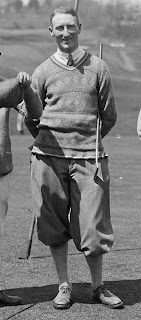Arthur Havers, Golfer Who Won the Open Championship
Full name: Arthur Gladstone Havers
Date of birth: June 10, 1898
Place of birth: Norwich, Norfolk, England
Date and place of death: December 27, 1980 in Haslemere, Surrey, England
Winning the Open, Plus Other Major Finishes
Arthur Havers won the 1923 British Open. It was first Open played at Troon, and the last Open won by a Briton until Henry Cotton at the 1934 Open.An opening 73 left Havers one off the lead. Another 73 in Round 2 moved him into a tie for the lead, one stroke in front of defending champion Walter Hagen. Yet another 73 put Havers into the solo lead, with Hagen two back in fourth place.
In the final round, Havers shot 76 and Hagen 75, giving Havers the one-stroke victory. But it all came down to 18th-hole drama. Havers' approach to the final green landed in a bunker. But he holed his next shot to finish on 295. When Hagen reached the hole, he wound up in the same bunker — but Hagen's pitch out narrowly missed the hole, giving Havers the victory.
Havers had several other high finishes. He was fourth in the 1921 British Open and third in the 1932 Open. His other Top 10s in the Open Championship were seventh-place ties in 1920 and 1927, and a tie for 10th in 1931. He first played in the Open in 1914, and last in 1949.
Havers played in the U.S. Open only twice, making the cut once: a tie for 15th place in 1927.
Havers' Pro Tournament Wins
- 1921 Northern Professional Championship
- 1922 Northern Professional Championship
- 1923 British Open
- 1923 Glasgow Herald Tournament
- 1923 Heath and Heather Tournament
More About Arthur Havers
Havers first qualified for the British Open at the age of 16. And in the early 1920s he appeared on his way to being a major player in British golf. He certainly was in 1923, when he won two other important tournaments in addition to the Open.Following the Open, Havers went on an exhibition tour in the United States, during which he defeated Bobby Jones, 2-and-1, and Gene Sarazen, 5-and-4.
But there were no more significant tournament wins for Havers after 1923, even though he was only 25 years old. (He looked older because of a prematurely receding hairline combined with a bowlish, monk-style haircut.)
What happened? A 1930 newspaper article in Australia, where Havers was set to tour, said that Havers was "a curious instance of lost form at golf ... After (winning the Open in 1923), he toured America with James Ockenden, and since then has never made even a decent showing in first-class company."
One issue is that Havers sometimes battled the shanks. In his book The Who's Who of Golf (affiliate link), Peter Alliss wrote of Havers: "... He could at times look a very inferior player. He had a four-knuckle, left-hand grip and made little use of his right hand. The swing a lunging one with the hands too far in front of the clubhead. At times, the result was one shank after another. Havers ... always appeared unmoved, as if these monstrosities were no concern of his."
Even the official website of the Open Championship, opengolf.com, disparaged Havers' swing, saying that Havers:
"(H)ad neither the appearance nor the swing of an Open champion. An early loss of hair gave him the look of a monk when he removed his voluminous cap to receive the trophy and his swing had neither the grace nor rhythm of many of his contemporaries."
Another idiosyncrasy of Havers: He advocated gripping the club very tightly, advice that was and is anathema to generations of golf instructors. However, he was selected to write the chapter on driving in the 1925 book, How to Improve Your Golf: Lessons By British Masters.
These issues, and the failure to replicate his 1923 success, didn't prevent Havers from still being good enough to represent Great Britain in international matches for a decade after his British Open win, however.
He played in three Ryder Cups (1927, 1931, 1933) after also having played in two precursors to the Ryder Cup, Great Britain vs. USA matches in 1921 and 1926 (both won by the British).
In six Ryder Cup matches, Havers went 3-3-0, including 2-1-0 in singles. In 1927, he lost to Walter Hagen 2-and-1; in 1931, Havers beat Craig Wood, 4-and-3; and in 1933 he defeated Leo Diegel, 4-and-3. Havers was 2-0 in the 1933 Ryder Cup won by the British.
Alas, Havers shares a Ryder Cup record one doesn't want to have: worst loss. In the 1931 Ryder Cup, Havers and partner George Duncan lost in foursomes to Hagen and Denny Shute, 10-and-9 (36-hole match), tied for worst loss in tournament history.
Havers also represented his country in the France-Great Britain Professional Match in 1929, and repped England in three England-Scotland Professional Matches (1932, 1933, 1934), all on the winning side.
During and after his playing days, Havers worked as a club professional. Over the years he served as the pro at these England clubs: Moor Park Golf Club in Hertfordshire; West Lancashire Golf Club in Blundellsands; Coombe Hill Golf Club in Kingston; Sandy Lodge Golf Club in Northwood; and Frinton Golf Club at Frinton-on-Sea.
He was at Frinton from 1956 until his retirement in 1964. Today, Frinton offers the Arthur Havers Bursary, a scholarship fund for junior golf. In 2007, the main golf course at Frinton was renamed The Havers Course.

